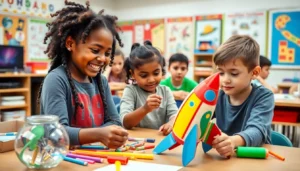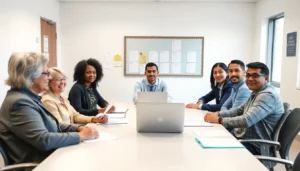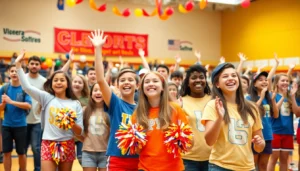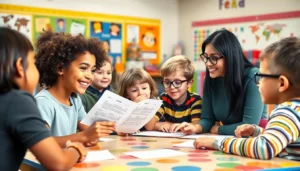Table of Contents
ToggleIn a world where traditional classrooms often feel like a scene from a sitcom gone wrong, alternative education academies are stepping in as the cool kids on the block. They’re shaking things up, proving that learning doesn’t have to be a snooze-fest filled with dusty textbooks and monotonous lectures. Instead, these innovative institutions focus on personalized learning experiences that cater to each student’s unique strengths and interests.
Overview Of Alternative Education Academy
Alternative education academies prioritize personalized learning experiences, aligning education with students’ unique strengths and interests. Such institutions often adopt innovative teaching methods that make learning engaging and enjoyable. Emphasizing critical thinking and problem-solving skills, these academies foster creativity and self-expression.
Flexible curricula allow students to progress at their own pace, ensuring mastery of essential concepts before advancing. Diverse instructional approaches, including project-based learning and experiential activities, cater to varied learning preferences. Class sizes are typically smaller, resulting in more individualized attention from educators.
Many alternative education academies incorporate technology, using digital tools to enhance learning. Students engage with interactive platforms that promote collaboration, facilitating learning beyond traditional boundaries. Research indicates that these methods can yield improved academic outcomes and enhanced student satisfaction.
Community involvement plays a crucial role in the success of alternative education academies. Partnerships with local organizations often enrich the curriculum and provide students with real-world experiences. These collaborations not only expand learning opportunities but also foster a sense of belonging and responsibility.
Alternative education academies attract families seeking an unconventional approach to education. Parents value the emphasis on holistic development, which prioritizes emotional and social growth alongside academic achievement. By nurturing well-rounded individuals, these institutions contribute to the development of future leaders who are equipped to navigate an increasingly complex world.
History Of Alternative Education
Alternative education roots extend back to the early 20th century when educators sought methods outside traditional models. Innovative thinkers like John Dewey promoted experiential learning, emphasizing the integration of real-world experiences into the curriculum.
Key Milestones
In 1960, the rise of Montessori schools marked a significant milestone, focusing on student-led exploration. The 1970s saw the emergence of unschooling, encouraging learning through life experiences rather than structured lessons. Additionally, the establishment of charter schools in the 1990s provided more flexibility and choice for families. Each milestone reflects a shift towards personalized learning, catering to individual student needs.
Notable Influences
Maria Montessori’s methods significantly impacted early alternative education philosophies. Her child-centered approach inspired educational leaders to prioritize independence and curiosity. Meanwhile, Ivan Illich’s “Deschooling Society” challenged conventional schooling, advocating for learning outside traditional institutions. In more recent years, technology has also played a crucial role, enabling online education platforms and blended learning environments. These influences continue to shape the evolution of alternative education today.
Types Of Alternative Education Academies
Alternative education academies encompass various models, each offering unique approaches to learning. These models emphasize creativity, collaboration, and personalized education.
Montessori Schools
Montessori schools focus on self-directed learning, encouraging children to explore subjects at their own pace. Emphasis on tactile learning experiences fosters independence in students. Educators guide rather than instruct, allowing children to choose activities that resonate with their interests. Classrooms feature mixed-age groups, promoting peer learning and mentorship. Research shows Montessori students often excel in critical thinking and problem-solving skills compared to their peers in traditional settings.
Waldorf Education
Waldorf education emphasizes holistic development, integrating arts and academics to nurture creativity. Curricula are designed around developmental phases, aligning lessons with students’ maturity levels. Teachers often stay with the same class for several years, strengthening relationships and fostering community. Emphasis on play and imagination cultivates emotional intelligence and social skills. Studies indicate that this approach supports deep thinking and engagement in learning.
Democratic Schools
Democratic schools empower students with choice in their learning process and governance. Students participate in decision-making, creating a sense of ownership over their education. Class structures often include mixed ages, promoting collaboration and mentorship among peers. Freedom to pursue individual interests leads to a more engaged learning environment. Evidence suggests that students from democratic schools develop strong self-motivation and critical thinking abilities.
Benefits Of Alternative Education Academy
Alternative education academies provide numerous advantages that cater specifically to individual learning needs. These benefits contribute to a more effective educational experience.
Individualized Learning
Individualized learning remains central to alternative education. Each student receives tailored instruction, aligning with their distinct strengths and interests. This customization allows learners to progress at their own pace. Smaller class sizes facilitate closer relationships between educators and students, enhancing support. Teachers adapt their methods based on feedback, ensuring no student falls behind. Furthermore, alternative academies often utilize diverse teaching techniques. Project-based assignments and hands-on activities engage students more deeply. Learners experience increased motivation and enthusiasm, as lessons resonate with their personal experiences.
Development Of Critical Thinking Skills
Critical thinking skills receive significant emphasis in alternative education. Academies promote challenges that stimulate analytical thought and problem-solving abilities. Students regularly engage in discussions that encourage multiple perspectives. Real-world applications of knowledge foster a deeper understanding of complex topics. Through experiential learning, students develop the ability to understand and address contemporary issues. Teachers provide rich, immersive experiences that inspire curiosity and creativity. Additionally, collaborative projects encourage teamwork, enhancing communication and interpersonal skills. This approach equips students with the confidence needed to tackle challenges in various contexts, preparing them for future success.
Challenges Faced By Alternative Education Academy
Alternative education academies encounter several challenges. Addressing these issues is vital for their success.
Public Perception
Public perception presents a significant hurdle for alternative education academies. Many view these institutions as less rigorous than traditional schools. Misunderstandings about alternative methods often lead to skepticism among parents and stakeholders. Despite the proven benefits of personalized learning, these academies struggle to gain recognition. Building trust and showcasing success stories are crucial steps in changing this narrative. Engaging in community outreach helps educators highlight the effectiveness of their unique approaches. Ultimately, fostering better understanding can bridge the gap between perception and reality.
Funding Issues
Funding issues frequently challenge alternative education academies. Limited financial resources hinder their ability to implement innovative programs. Many rely on grants and donations, creating unstable revenue streams. Without consistent funding, sustaining high-quality facilities and diverse curricula becomes difficult. Securing adequate funding is essential for attracting qualified staff and maintaining small class sizes. Exploring partnerships with local businesses and organizations might provide additional financial support. Pursuing various funding opportunities remains crucial for the long-term viability of these institutions.
Alternative education academies represent a transformative approach to learning that prioritizes individual strengths and interests. By fostering critical thinking and creativity these institutions create an engaging environment that prepares students for future challenges. Smaller class sizes and diverse instructional methods enhance personalized attention and support.
Despite facing challenges such as public perception and funding issues these academies continue to attract families seeking a more tailored educational experience. Their commitment to holistic development not only nurtures academic success but also cultivates well-rounded individuals ready to thrive in a complex world. As alternative education continues to evolve it holds the promise of redefining how society views learning and success.






